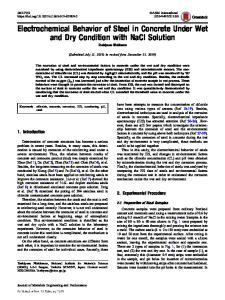Analytical Study of CuZn 30 and CuZn 39 Brass Surfaces in 3% NaCl Solution Under Polarization
- PDF / 10,336,466 Bytes
- 13 Pages / 595.276 x 790.866 pts Page_size
- 94 Downloads / 549 Views
ORIGINAL ARTICLE
Analytical Study of CuZn 30 and CuZn 39 Brass Surfaces in 3% NaCl Solution Under Polarization Amina Dridi1,2 · Leila Dhouibi1,3 · Jean‑Yves Hihn2 · Patrice Berçot2 · El Mustafa Rezrazi2 · Wafa Sassi4 · Nicolas Rouge2 Received: 20 June 2020 / Accepted: 26 August 2020 © The Tunisian Chemical Society and Springer Nature Switzerland AG 2020
Abstract The main objective of the investigation is to identify the role of beta phase on the corrosion behavior of CuZn alloys in chloride solution. The experimental study was based on the characterization and identification of the anodized brass films formed on the surface of two alloys: CuZn30 and CuZn39, abbreviated by CuZnα and CuZnαβ. Oxidation was carried out at different potentials chosen from the anodic polarization curves recorded beforehand with the two alloys. The main analysis techniques are AFM, SEM, EDS and XRD. Results indicate that the corrosion mechanism is similar for both alpha and alpha beta brasses and followed the same succession of steps. Nevertheless, the rate of dezincification is higher in the case of CuZnαβ: the surface of the attack is larger, and different plugs could be created at the same potential. Therefore, the composition of the protective layer is more diverse than that of CuZnα, while much more varied oxide and hydroxide species are likely to be formed. Keywords Alpha CuZn · Alpha beta CuZn · Dezincification process · Protective film · Crystallographic properties · Corrosion mechanism
1 Introduction Brass is frequently exposed to solutions with a high chloride content [1], for example in the case of seawater desalination plants, due to its interesting properties such as high formability, electrical [2] and thermal conductivity, etc. [3, 4]. Moreover, brass degradation due to pitting corrosion in chloride-containing solution leads to structural failure and serious economic losses [5, 6]. Therefore, the stability of Cu–Zn alloys in seawater has been extensively studied, while investigating different parameters: temperature [7], adding an alloying * Jean‑Yves Hihn jean‑yves.hihn@univ‑fcomte.fr 1
Université de Tunis El-Manar, Faculté des Sciences de Tunis, Equipe COPROMET, Laboratoire de Recherche Mécanique Appliquée et Ingénierie (ENIT), 1002 Tunis Belvédère, Tunisia
2
Institut UTINAM–UMR 6213, CNRS Univ. Bourgogne Franche-Comté, 25030 Besançon Cedex, France
3
Université de Tunis, IPEIT, 1089 Montfleury Tunis, Tunisia
4
UREME (UR17ES45), Faculté des Sciences, Université de Gabès, Cité Erriadh, 6072 Gabès, Tunisia
element [8–10], immersion duration [11], pH [12, 13], [Cl−] [14], surface inclination [13], inhibitor presence [15–21] …). With regard to C l− ion attack, a previous study has confirmed that the rate of corrosion of brass alloys in chloride solutions increases and their breakdown potential shifts to more negative values as the Zn content increase [9, 22]. In other words, the α-β brass, face-centered cubic (FCC), has a lower corrosion resistance than the α-phase with only centered cubic phases (C
Data Loading...











